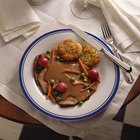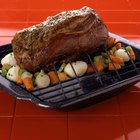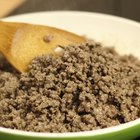
Veal sirloin differs from beef sirloin in a couple of ways, mainly physiological, but they also share a few common qualities. Like beef sirloin, veal sirloin comprises several different muscles and includes portions of the hip bone and backbone. Since veal bones haven't completely hardened, they contain a lot of rich, velvety marrow and soft connective tissue, both of which melt like butter -- the main difference between beef and veal, besides age. Whole veal sirloins only weigh about 3 or 4 pounds, but pack a lot of flavor per ounce, especially when cooked at a low temperature.
Whole Sirloin
Step 1
Remove the sirloin from the refrigerator about an hour before cooking it and let it reach room temperature in a shallow dish.
Step 2
Pat the sirloin dry with paper towels and coat with a thin sheen of oil. Season the veal liberally with kosher salt and freshly ground black pepper. You can also make a spice paste using oil as the base to season the sirloin. Mix the fresh herbs and spices of your choice with enough oil to form a paste and slather it all over the veal. Rosemary, sage and lavender pair well with veal's mildly sweet flavor.
Step 3
Tie the sirloin tightly at 1-inch intervals crosswise with kitchen twine. Tie the roast once lengthwise with kitchen twine.
Step 4
Heat 2 or 3 tablespoons of high-temperature fat in a cast-iron skillet or heavy bottomed pan on the stove over medium heat. You want a fat with a light flavor and high smoke point when searing veal. Clarified butter, canola oil and extra-light olive oil are a few that fit the criteria.
Step 5
Heat the oven to 225 degrees Fahrenheit. Place the sirloin in the pan when the fat "dances," or appears to ripple. Sear the veal on all sides until golden brown, using tongs to rotate it as needed.
Step 6
Place the veal in the oven if you used a cast-iron iron skillet. If you didn't use an oven-safe pan, transfer the sirloin to a shallow dish and move it to the oven.
Step 7
Roast the veal for about 30 minutes per pound for medium-rare, or about 1.5 hours. Check the temperature in the center of the sirloin with a meat thermometer after about an hour.
Step 8
Remove the veal when it reaches 125 degrees Fahrenheit for medium-rare, 130 degrees for medium and 145 degrees for well-done.
Step 9
Transfer the sirloin to a shallow dish to rest for at least 30 minutes after you take it out of the oven. The sirloin will retain more juice and its internal temperature will rise about 10 degrees while resting.
Steak
Step 1
Take the sirloin out of the fridge about 15 minutes before starting and let it reach room temperature.
Step 2
Season the steak on both sides with kosher salt and freshly ground black pepper. Add herbs and spices as you like. Herbes de Provence, a classic combination of dried thyme, savory, basil and fennel, brings out a robust, woodsy quality in the taste of veal.
Step 3
Heat a couple tablespoons of fat over medium heat in an oven-safe pan, preferably a cast-iron skillet. Clarified butter, extra-light olive oil or canola oil do the job. Heat the oven to 350 degrees Fahrenheit.
Step 4
Lay the veal in the pan and sear on both sides to golden-brown, about 1.5 to 2 minutes on each side. Use tongs to turn the sirloin.
Step 5
Place the pan in the oven and roast for about 6 minutes for medium-rare and 8 minutes for medium. Anything more than 8 or 9 minutes and you have well-done veal.
Step 6
Remove the pan from the oven after the steak finishes and transfer the steak to a plate to rest. Return the pan to the stove and set the heat to medium if you want to make a pan gravy.
Step 7
Pour about 1/3 cup of stock or water in the pan and scrape the bottom with a wooden spoon. Cook the liquid until syrupy and swirl in 1 tablespoon of butter and a touch of cream. Pour the gravy over the veal. Other sauce options include a beurre blanc, made with shallots, white wine, lemon juice, cream and butter, or a red wine and mushroom sauce.
Related Articles

How to Cook a Beef Topside Roast

Slow Cooking an Eye of the Round Steak ...

How to Cook a Tender Top Sirloin Roast

How to Cook Kobe Steaks

How to Cook Ultra Thin Sirloin
How to Cook a Lamb Square Cut Shoulder

How to Cook Alligator Steak

How to Cook Axis Deer Steaks

How to Cook an Elk Shoulder

How to Cook Lamb Chuck

How to Cook a Bone-in Leg of Lamb
How to Slow Cook a Pot Roast With Beef ...

How to Pan Cook a Sirloin to Medium-Well

How to Sear Tenderloin Steak and Cook ...
Cooking Guide for Semi-Boneless Beef ...

How to Make a Tender and Juicy Pot Roast

How to Cook a Whole Sirloin Tip Beef ...

How to Slow Cook an Eye of Round Roast ...

Can Chuck Roast Be Used for Stew?

How to Cook Beef Mince
References
Warnings
- The U.S. Department of Agriculture recommends cooking veal to a minimum internal temperature of 145 degrees Fahrenheit.
Writer Bio
A.J. Andrews' work has appeared in Food and Wine, Fricote and "BBC Good Food." He lives in Europe where he bakes with wild yeast, milks goats for cheese and prepares for the Court of Master Sommeliers level II exam. Andrews received formal training at Le Cordon Bleu.
Photo Credits
Hemera Technologies/PhotoObjects.net/Getty Images